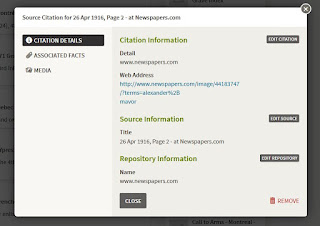Sometimes I come across something that intrigues me.
I was at the Hathitrust Library website, going through a
Stone Cutter's Journal for 1919 when I saw this photo.
The caption reads:
Wm Walker. Brother Walker was last a member of Bedford, Indiana Local. He enlisted in the Canadian Army and after several months of service died in the Royal Victoria Hospital, Netly, England September 6, 1918.
It made me curious as to why a young man from Indiana would enlist in Canada? I wanted to find out who he was.
Since he enlisted in Canada I first I went to Library Archives Canada to search the database of Soldiers of the First World War. There were way too many William Walkers. So I went to the
Canadian Virtual War Memorial and searched by date of death. There he was. Private William W Walker, Service Number 2502965, born to William and Helen Walker in Ayr, Scotland, husband of Margaret Hunter Walker of Bedford, Indiana. He enlisted in the Army, the 32nd
Canadian Forestry Corps and died Sept 6, 1918 at the age of 45. So he was not that young when he enlisted.
Now that I have the Service Number I could look again in the
database at LAC. I see his birth date is 19 October 1873 in Ayr.
Doing a little research with the information I now had, this is what I found about his life.
William Walter Walker was born 19 Oct 1872 to William Walter Walker and Helen Craig in Ayr Scotland. According to the 1881 census William was living in Ayr with his parents, a brother John, a sister Catherine and a half brother James Craig. In about 1892 William married Margaret Williams Wylie, daughter of James Wylie and Jane Williams.
On the 1901 census of Scotland William, a stone mason, and his wife Margaret live in Glasgow.
On May 13, 1905 William set sail aboard the Furnessia from Glasgow with $40 in his pocket, to arrive in New York on the 23rd of May, where he was to stay with John Craig. Margaret followed in September that year.
According to the 1910 US census William and Margaret are living in Chicago, where William works as a Stone Cutter. They don't seem to have had any children. I then found William a stone worker, and his wife Margaret in the Bedford, Indiana city directory for 1915, living at 623 15th Ave.
I didn't find any border crossing records into Canada for him, but William enlisted at Winnipeg, Manitoba on 17th Sept 1917.
William is buried in
Grave A 7954 at the Glasgow (Riddrie Park) Cemetery, Glasgow Scotland. There are documents available for download at the
Commonwealth War Graves Commission site. One of the documents is a request from Margaret Hunter to have written on his grave "He did his duty."
In October 1920 Margaret Walker applied for an Indiana marriage license to wed Daniel Hunter, a stone cutter in Bedford.
I still don't know why William came to Canada to enlist, but I hope he has family somewhere to remember him.
































